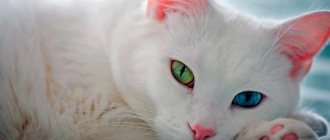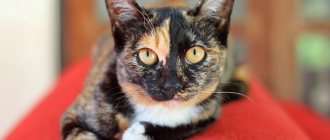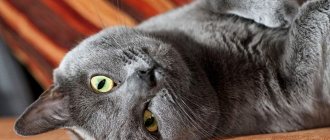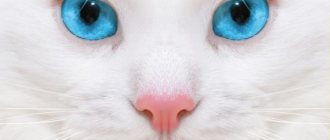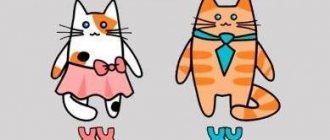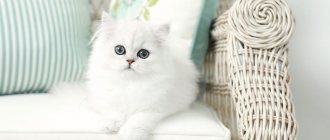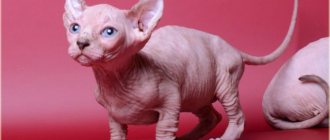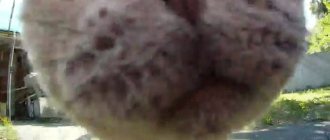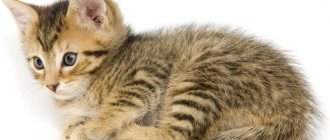6326Pavel
Since ancient times, it was believed that cats with different eyes bring good luck to every home. Now modern scientists are constantly arguing and do not agree on what this interesting phenomenon is connected with. Some argue that different eyes in a cat are a mutation, others believe that this phenomenon indicates the presence of some hereditary disease in the animal.
It is worth looking at this phenomenon in more detail. On the one hand, we are faced with the so-called difference of eyes (scientifically called heterochromia, from the Greek geteros - different, different, and chroma - color). This is what they call eyes with different colors of the iris of the left and right eyes, or different shades and colors of different parts of the iris on one eye. This phenomenon can be found in people and some animals, most often in cats. Heterochromia is complete when one eye is bright blue, and the second can be, for example, golden, green or another color. Less commonly, cat eyes are partially heterochromic.
Which color can be called the most stylish and royal? Opinions will be divided, but, perhaps, the leading position will be taken by white. White cats look the most regal and beautiful. In combination with a pink nose, the same color ears and pads on the paws, they look unusually elegant.
Let's look at several of the most popular breeds today, among which there are often cats with eyes of different colors.
© shutterstock
The phenomenon of different eyes
Experts identify the following breeds of white fluffies that delight owners with their heterometry:
- The Turkish Van is a cat that glorified Turkey outside the country; a monument was even erected in its honor. “Fluffy” is distinguished by a gentle disposition and loving nature; to keep the animal in a great mood, it is enough to stroke the purr every day. The cat's fur is soft and velvety, so touching it is a real pleasure. The animal is faithful and devoted, directly clinging to members of its family, gratefully giving warmth for the care and attention provided. Like any other pet, it is important for the Van breed to choose one owner. By the way, the color of the fur can be very different, if the main color is white, inclusions can be red, black, blue and cream. In this breed, many kittens are born with one yellow eye and the other sky blue.
- A special white cat with different eyes, the Khao Mani is a breed bred in exotic Thailand. Even if a kitten is born with spots, after a couple of years they noticeably lighten or disappear altogether. Thoroughbred offspring are not cheap, but when you buy a luxurious beauty, you get a faithful friend who loves to take care of himself and is clean. Even the kings of Thailand admired khao mani. Seeing your pet for the first time, it is impossible to pass by the unusual eyes - one silver and the other golden. Don't be surprised if your kitty has trouble hearing - the gene responsible for heterochromia deprives most white cats of hearing in one ear, and on the blue eye side. The good news is that the animal’s vision is excellent.
- The Turkish Angora is a white cat with blue or multi-colored eyes. The character is good-natured, sociable, playful, the animal is capricious in food. Therefore, the owner needs to approach the selection of a diet for a furry cat especially carefully, respecting its pretentious tastes. The purebred animal has good immunity, which successfully fights viruses and bacteria without causing trouble to the purr and the owner.
Variegated eyes as a phenomenon has a scientific name - heterochromia (from the Greek heteros - “different”, chromos - “color”). Heterochromia, different pigmentation of the iris, results from varying concentrations of the pigment melanin and occurs in both animals and humans. Gender does not matter in this case, although according to statistics, females with this phenomenon are more common. Heterochromia is often inherited and does not affect visual acuity in any way. The most common combination of different eyes is blue and brown; in felinology it is called copper.
Breeding Angora cats
Before buying a kitten, a breeder needs to know a lot. Mandatory minimum education: cat genetics courses, felinology courses and minimum veterinary literacy. This is very important - only knowledge will allow you to breed healthy and high-quality representatives of the breed.
The work of a breeder is full of worries:
- first of all, it is necessary to constantly participate in exhibitions and receive titles and markings;
- secondly, selling expensive and purebred kittens is very difficult;
- thirdly, you will have to spend a lot of money on a veterinarian, food, and cat supplies.
The work of a breeder is not easy, but interesting.
But if you are ready for all the difficulties and have all the necessary knowledge, then you can choose a cat. There are some things to keep in mind:
- It is better for a novice breeder to purchase a cat or a breeding pair immediately;
- animals should be chosen show or breeding class;
- there should be no deaf ancestors in the pedigree of the Angora cat, and the kitten itself must be healthy;
- Be sure to choose cats from a good cattery with all the documents;
- When purchasing, a sales contract is drawn up, which stipulates that the breeder agrees to give the cats for breeding. With the kitten, you must receive its pedigree or birth certificate and veterinary passport.
As soon as you have purchased cats, you must register your cattery and its producers. To do this, you need to contact the breed club or the club of the felinological organization in which the breed is recognized. There you will be given the necessary documents and registration, which will include the name of the club, the number of breeding sires and other necessary information. If you wish, you can also register a nursery seal with the club.
It is very important that partners are compatible by blood type
If you decide to spay or neuter your pet, the optimal age for this is 6-7 months.
The next step will be an exhibition where the club's manufacturers need to be presented. There, the cat must receive a rating of at least “very good”, valid for a year, and the cat must receive a rating of at least “excellent”, valid for a year. If desired and possible, the animal can close the title and receive a title certificate, which is valid for life.
After this, you can start looking for a partner. It is better to do this at exhibitions and among nurseries that provide cats for mating. Online platforms and advertisements are not suitable, since you rarely see truly purebred animals there.
Criteria for choosing a partner:
- full compliance with the standard;
- availability of a confirmed pedigree, veterinary passport and a valid divorce appraisal or title certificate;
- if your cat is mating for the first time, then the cat should not be mating for the first time;
- the cat should not be younger than 1 - 1.5 years. The female also mates for the first time no earlier than 1.5 years;
- blood group compatibility. You can find this out from your veterinarian. Compatibility scheme: female of group A - males of groups A and B;
- female of group B - males of group B;
- male of group A - female of group A;
- male of group B - females of groups A and B.
As soon as a suitable partner is found, you need to contact the club where your nursery is registered and get a referral for mating, written down on a special form. If you have two cats, you need to do this for both. The partner must also have a referral from his club.
To breed cats you need to get directions from the club
Mating always takes place on the cat's territory. You need to prepare for mating in advance:
- draw up an agreement stipulating re-mating in case the first one is unsuccessful and payment - in a kitten or in cash;
- transport the cat's belongings to the cat's territory: bowls, a supply of food for 3-4 days, a bed and a scratching post. The cat's owners must provide a separate safe room for mating;
- trim the cat’s claws - she may scratch the cat during his “persuasion”;
- wait for the heat and take the cat to the cat for 2-3 days.
How to understand that a cat is pregnant:
- sudden cessation of estrus at an uncharacteristic time for the cat;
- changes in the cat’s character and habits;
- a month after estrus, the cat’s stomach noticeably enlarges;
- nipples swell and turn pink starting from the third week, at which time vomiting appears in the morning;
- the cat's appetite increases;
- From the third week, the cat can be taken for an ultrasound. If she does not become pregnant, the mating must be repeated during the next heat.
Japanese Bobtail
A striking representative of tailless cat breeds. It can be either short-haired or long-haired. Pure white bobtails are extremely rare. The most common color is bicolor - a snow-white body with black or red spots at the base of the tail or on the head. Bobtails are very agile, intelligent, and easy to train, so if you wish, it will be easy for you to teach your pet a couple of circus tricks.
How to embrace the immensity: the main varieties of cat colors
Diversity is diversity, but no one has canceled systematization. Therefore, all possible colors of cats were divided into several groups.
Table: main groups of cat colors
| Color group | General characteristics of the color group | Colors included in the group | Description of color |
| Solid colors | All hairs are well dyed to the roots, without patterns or any stains |
|
|
| Silver colors | A certain area of each hair is bleached white |
|
|
| Acromelanistic colors (colorpoint) | Body slightly colored, light (from white to cream); paws, tail, muzzle and ears are darker. |
|
|
Causes of heterochromia
This anomaly occurs not only in cats, but also in humans. This unique phenomenon is called heterochromia.
The reason that the irises of the eyes are colored different colors may be a lack of melanin in the body or, conversely, its excess amount. Melanin protects the skin from ultraviolet radiation. The color of the irises depends on how much melanin is contained and how it is distributed.
In complete heterochromia, one cat's eye is blue, while the other may be green, yellow or orange. Cats that have the W gene are genetically predisposed to this anomaly.
We still haven’t figured out exactly what heterochromia is. Is it a mutation or a gift that makes animals with different eyes seem even more attractive and mysterious? There are few reasons for heterochromia, but they all have a different nature. So:
- Genetic predisposition (many cats carry the white-haired gene in their DNA for many generations, and with it the gene for different eyes). Moreover, these genetic abnormalities can appear in any individual in any offspring;
- Past illnesses (very often the causes of such changes in the iris can be leukemia, various oncological diseases, etc.);
- One of the main causes of heterochromia is a lack of melanin pigment in the body, which is responsible for the color of the iris.
Interestingly, slightly less than half of cats diagnosed with heterochromia also have hearing problems. Usually this is deafness in one ear, sometimes in two. True, official veterinary statistics still reassure owners of odd-eyed cats. According to these data, about 70% of cats with heterochromia hear absolutely normally and this mutation does not cause them any problems.
Nutrition
The most important thing in nutrition for an Angora cat is balance and the presence of all necessary microelements. You can feed your cat both ready-made food and natural products.
Brands of food for Angora cats
Angora can be fed holistic, premium and super-premium food. Top 5 foods for Angora cats include:
- Carnilove Duck&Turkey Grain&Potato Free. Holistic food, manufacturer - Czech Republic. The food contains only natural products and is produced according to the Grain&Potato Free formula - without grains and potatoes. Main composition: duck fillet - 32%;
- chicken fillet - 32%;
- yellow peas - 16%;
- chicken fat - 11%;
- apples - 6%;
- tapioca extract - 3%;
- chicken giblets - 3%;
- fish oil - 1%;
- carrots - 1%;
- flax seed - 1%.
- lamb - 8%;
- chicken - 18%;
- lamb - 20%;
- chicken fillet;
What food is suitable for kittens:
- Royal Canin Kitten (France, premium);
- Royal Canin Kitten Sterilized (France, premium, for sterilized kittens);
- Orijen Cat&Kitten (USA, premium);
- Acana Grasslands (Canada, holistic);
- 1st Choise Kitten With Chicken (USA, super premium).
Photo gallery: food for Turkish Angora
Canidae Grain Free Pure Elements with Fresh Chicken
Carnilove Duck&Turkey Grain&Potato Free
Acana Grasslands
Orijen Cat&Kitten
Hill's Science Plan Feline Adult Optimal Care with Lamb
Natural nutrition
What can you give an Angora cat:
- meat and offal: lamb, beef, chicken, rabbit, lamb, kidneys, heart and liver. Everything should be boiled or boiled. Share in the diet - 65%;
- porridge - rice, oatmeal, buckwheat. Wheat and corn are not allowed. Share in the diet - 15%;
- all vegetables except onions, garlic and potatoes. They should be ground fresh or boiled into a paste. It is useful to add fresh seaweed to the gruel. Share in the diet - 10%;
- cottage cheese, kefir, natural yogurt, yogurt. The share in the diet is 5–6%; dairy products should be divided into several doses per week;
- quail eggs - 3-4 per week, chicken eggs - 1-2 times. Give raw;
- white boiled sea fish - 2-3 times a week, no more than 20 g at a time.
The daily norm is 140–170 g. The cat is fed 2 times a day with a mixture of 3 parts meat, 1 part vegetable pulp and 2 parts boiled cereal.
You should not give your cat food from the human table, especially sweets and seasonings.
What an Angora cat can’t do:
- canned food;
- pork;
- cheese;
- seasonings;
- economy class food like Kitiket and Whiskas;
- sweets;
- river fish. This is very important, since the substances contained in it destroy vitamin B1, which can lead to the development of ataxia;
- any food from a person's table.
Burmilla
Graceful aristocrats. These cats have long or short haired silver coats and expressive eyes of emerald or amber color. The breed standard does not include a perfectly white color - often the muzzle, back and tail of these cats are slightly darker than the color of the body. But this in no way spoils the beautiful Burmilla, making her even more unusual and attractive.
No matter what breed a white cat is, it is always gorgeous. In many countries, snow purrs are a symbol of peace, love and light. If you are going to buy yourself a purring pet, think about its white color. Such a cat will not only become the keeper of the hearth, but also your most faithful and devoted friend!
Is a white cat with different colored eyes a special breed?
Not only purebred cats can be heterochromic; this phenomenon is also observed in outbred animals.
Many people mistakenly think that a white cat or a white cat with different eyes are representatives of some special breed. Indeed, among representatives of some breeds, for example, Turkish Van, Turkish Angora or Kao Mani, heterochromic individuals are very common.
But the British, the Scots, the Persians, the Maine Coons, the Rexes, and the most ordinary yard cats can all have different eyes. For example, the world-famous snow-white beauties with different eyes, Iris and Abis from St. Petersburg, are mongrel.
Choosing a kitten
When choosing a kitten, it is worth considering that according to the standard, kittens with a chocolate, lilac or Himalayan color are not considered pedigree and should be discarded. A slight squint in a Turkish Angora kitten is acceptable and is not considered a deviation from the norm.
An Angora kitten can be separated from its mother no earlier than 2 months after birth.
How much a kitten costs will depend on the breed characteristics of the parents, their pedigree and the body structure of the baby.
The video shows Angora kittens playing with each other.
Maine Coon
Cats of this breed are famous for their considerable size. They come in a variety of colors, with pure white being quite rare. In addition, according to the standard, only its ideally pure shade is allowed, without any color inclusions. At the same time, most snow Maine Coon kittens are born with colored spots on the head and body, which subsequently disappear completely. The white Maine Coon is gorgeous - its rich flowing coat is unusually soft and silky and at the same time requires no more care than wool of any other color. The main features of this breed are the presence of charming tassels on the cat’s ears and incredibly thick fur. Unfortunately, like most snow-white cats, white Maine Coons often suffer from deafness and heterochromia.
How to choose a Turkish Angora
Before choosing a kitten, decide on the purpose: why you need it. After that, select a class:
- Show. The best cats, fully complying with the standard. They are used in exhibition careers and for breeding. The price for a show-class Turkish Angora is from 30,000 rubles;
- Breed. Suitable for breeding, does not participate in exhibitions. Usually such cats have a minor flaw that does not allow them to become a champion at the show. The price for such a cat is 20,000 -30,000 rubles.
- Pet. A domestic pet cat that has a defect that prevents it from becoming a breeder or a champion at a show. Angora dogs with hearing impairment usually fall into this category. The price for such cats is from 10,000 to 20,000 rubles.
Deaf Angoras as pets are no worse than hearing ones: they are just as active, playful and loyal, and do not experience discomfort from their disadvantage.
How to choose a Turkish Angora kitten:
- First of all, you need to choose not a kitten, but a nursery. He must be authoritative, his cats must have awards from exhibitions. A good nursery is the key to a successful choice of a kitten. Remember also that a responsible breeder will not give away kittens under 3-6 months of age;
- Upon arrival at the nursery, first examine the kittens. If you wish, you can request all the necessary documents: pedigree or birth certificate, breeding list;
- Be sure to examine the kittens' parents and ask for their pedigrees. They must meet the standard. Kittens always look like their parents, this will help you choose the right kitten;
- It is easy to distinguish an Angora kitten from a Balinese (oriental long-haired) and a Forinwhite: Angoras have long hair from childhood, while Forins and Balinese are born short-haired and acquire a long coat by the age of one year;
- Also, the structure of the fur of Angoras and their distant relatives is different: in Turkish beauties it is more close-fitting and silky, there is not even a hint of undercoat, the collar and panties are thicker, and the ears are set much closer and higher, decorated with small tassels. Balinese and Foreign cats have less silky hair, no pants or collars or they are poorly defined, and their ears are set low;
Sometimes unscrupulous people can pass off Forinwhites and Balinese as Angoras, but they are easy to distinguish
Khao Mani
Another white cat with different eyes is Khao Mani. Kittens of this breed are commonly called “diamond eyes.” This breed of cat was bred in Thailand by order of the royal families, so the price of Khao Mani is quite high, and not everyone can buy it. This is especially true for representatives of the breed with different eyes. Thais are convinced that an odd-eyed cat can bring wealth, good luck and peace with tranquility to the house.
Khao Mani are short-haired cats with a small body size. Their main feature is the fear of loneliness, so they are extremely active and friendly. Cleanliness is also a hallmark of this breed, making them easy to care for.
From this video you will learn about the characteristics of the Khao Mani cat breed and how to care for them.
Keeping and caring for a cat
For a pet to look great, be healthy and cheerful, it needs care and attention. It may seem that caring for a purebred snow-white long-haired Angora is quite difficult, but it is not so.
It should be brushed approximately twice a week. For this purpose, you need to purchase a comb with sparse metal teeth. A slicker coat is not needed for this kind of wool, since it has no undercoat. The combing procedure, if the kitten is accustomed to it from an early age, does not bring discomfort to the animal, but, on the contrary, brings pleasure. Combing is necessary to get rid of old hairs, as well as to massage the skin, which improves blood circulation and, accordingly, the growth and condition of the coat.
Angoras are very clean and take care of their fur coat on their own. A cat only needs to be washed occasionally, as they say, on occasion. Such an occasion could be an exhibition or a visit to the veterinarian.
Bathing is also necessary if the cat has managed to get its luxurious fur coat very dirty, for example, while walking outside or knocking something over itself. These cats tolerate the washing procedure quite calmly, and can even enjoy it if they have been accustomed to water since childhood.
You should take care of your eyes daily by wiping them with a damp swab. Ears are cleaned as they become dirty, approximately once or twice a month. This must be done carefully, without deepening the stick into the ear canal.
Brushing your teeth is also necessary; for this purpose you should purchase a special brush and toothpaste. This cannot be done with human pastes.
Claws are trimmed as they grow. Your pet definitely needs a scratching post. Sharpening claws is inherent in the nature of all domestic cats: this is both exercise (especially if you pay attention to the position in which the animal does it), and the implementation of instinct, and maintaining its “weapon” in combat condition.
To keep a cat at home you will need a tray and litter. Cats are very smart and clean. Many Angora cats love to imitate their owner, including when relieving themselves, so they easily master the toilet.
Scottish lop-eared
Scottish Folds are very similar in appearance to the British. White coloring, extremely blue eyes and heterochemistry are just as characteristic of the Scots as their British counterparts. However, their distinctive feature - drooping ears - is absent among representatives of British breeds. Cats of this breed boast a luxurious plush coat with a thick, soft undercoat. These are typical couch potatoes who love to bask in warmth and comfort. At the same time, they are characterized by considerable independence. These purrs get along well with children and pets, will never refuse to play, but generally behave independently.
Origin story
The Turkish Angora, like many other domestic cat breeds, is believed to have descended from the domesticated African or Middle Eastern cat. These short-haired pets appeared in Egypt through movement from Turkey, after which the domestication process continued.
As a result of recent genetic studies, scientists have concluded that the Turkish Angora is a representative of the oldest cat breeds, and the length of the animal's fur is the result of gene mutations.
Interesting to know! About fifty years ago this breed was officially registered, although in the first four years only individuals with pure white coat color were registered.
Monument to Beauty
Unusual beauty has a downside - many heterochromic animals have serious hearing problems.
Alas, cats with different eyes are often deaf - completely or partially. Moreover, in the latter case, the ear located on the side of the blue eye usually does not hear. The cause of such deafness is genetic, it is the result of the action of the white color gene W. Its dominant allele blocks not only the production of color pigment, but also the development of hearing aid cells. Fortunately, breeders are resisting, and quite successfully, the spread of deafness of this kind in the population.
In Turkey, near the largest alpine lake, Van, there is a monument to white, odd-eyed cats of the Van breed.
At the entrance to the city of Van, not far from the lake of the same name, there is a monument depicting a pair of white cats with different eyes. This is very symbolic, and not only because the Turkish Van is a native breed of these places, but also because Van cats, unlike many of their counterparts, are calm about water and even swim beautifully and catch fish deftly. The Van breed has been declared a national treasure, and its image is embossed on a coin.
Characteristic diseases
The Angora is hardy, active and famous for its good health, but cat ailments such as:
- Oral diseases. It is necessary to regularly examine your teeth, brush them and remove tartar.
- Ataxia. It can be detected at the age of one month, so the risk of purchasing a kitten with such a problem is minimal.
- Congenital deafness. Those who breed Angora dogs at a certain stage conduct special tests to determine carriers of the bad gene.
- Diseases of the cardiovascular system. You should bring your cat to the veterinarian for examinations in a timely manner to detect the disease at an early stage.
Exotic
In many of their external characteristics, exotics are similar to the Persian cat, and this is not surprising, since these funny purrs with a “cute” expression on their faces are their direct descendants. The main distinguishing feature of the breed is their funny, slightly turned up snub nose. The snow color of the exotic is very rare and therefore very valuable. Their short fur, reaching no more than a couple of centimeters in length, is very soft and thick. It is difficult to find a calmer and more docile animal than this “plush” pussy.
Importance for pet health
Pets with different eyes are considered healthy, since this phenomenon does not affect vision. Heterochromia is most common in white and calico cats. Also, 30% of cats with this anomaly have hearing problems, specifically in the blue eye. The rest of the cats do not have any health problems, and white cats have excellent immunity.
If you are the owner of a pet with different eyes, then it is important to pay attention to some nuances. If the blue eye turns red, then most likely a blood vessel or hematoma has burst. In this case, you should consult a doctor who will prescribe appropriate treatment. The color of the eyes may change if a tumor appears on the eyeball.
Pets do not need special care. Pay attention to the eyes so that they don’t turn sour. If purulent discharge appears in the inner corner, you should visit a veterinarian.
Features of care
There is no need to take any mandatory measures to care for cats with different-colored eyes, the only thing is to pay attention to the nitrous oxide that has accumulated in the inner corner of the eye; if there is a lot of it and it is purulent, it’s time to see a veterinarian.
As for the snow-white coat, during the molting period it must be combed with a furminator, and the purr needs to be accustomed to the procedure from early childhood. It is better to put the slicker aside, otherwise the cat will lose its natural source of heat. If the coat is too long and tangles form, trimming will help in the summer.
https://www.youtube.com/watch?v=d0_i4GvNst4
Save and increase
For a hundred years now, the Ankara Zoo has been running a program to breed white Angora cats with different or blue eyes.
At the beginning of the last century, unusual Angora cats found themselves in danger of extinction: the gene for long hair was actively used in the development of new breeds, and there were catastrophically few purebred Angoras left. In 1917, Turkey decided to preserve the breed as a national treasure, and for some time local animals were even prohibited from being exported abroad.
Now other white cats with different-colored eyes are bred in the world - and the British Shorthair breed is not lagging behind in this. For example, a nursery for odd-eyed Britons operates in Rotterdam.
British cat with multi-colored eyes, Riviums cattery
Health and illness
This breed has quite strong immunity. To avoid diseases and infections common to all cats, you need to vaccinate your animals in advance.
Adult cats have a number of congenital diseases, such as deafness (often found in blue-eyed cats), as well as tartar. Kittens can suffer from ataxia - this is a violation of muscle movement, a motor disorder. Older cats may suffer from cardiomyopathy (symptoms: cough, shortness of breath, fatigue) or suffer from neoplasms.
If you take good care of the animal, they can live up to 20 years.
What breeds is this phenomenon typical for?
Khao Mani
We already know why cats have different eyes, now let’s look at which breeds this phenomenon is typical for. White cats look the most elegant and, as they say, royally. In addition, the pink nose and pads on the paws add special sophistication to these graceful purrs.
The domestic cat Khao Mani is a special breed that was bred in Thailand. The name of the breed is translated as “diamond eye” or “white pearl”. Previously, these cats were kept at the royal court. They were believed to bring peace and good luck to the home. Only many centuries later did they become available to ordinary people.
Cats have a small body size, a slightly elongated muzzle, and short hair. It happens that a kitten at birth has spots on its white fur. Over time, these spots disappear and it becomes completely white.
Buying such an exotic pet will not be cheap. But as a reward you will find a faithful friend, very clean. These beauties have unusual eyes: one is silver and the other is golden.
Turkish van
The animals have semi-long hair, an elongated body and strong limbs. The pussy is fluffy, very affectionate and tender. She loves to be petted by her owners. The animal literally follows on the heels of its owner. As soon as he sits down, she will immediately be in his arms and will faithfully look into his eyes to be stroked.
Pets enjoy conquering the “tops” of refrigerators and cabinets. They adore bath procedures to such an extent that they don’t mind swimming outside, even in a puddle. Pets are highly trainable. They offer their paw, follow the command “Sit!”, and bring objects in their teeth.
The pet's fur is soft and velvety. An amazingly loyal animal rewards its owners with warmth and loyalty for their care and attention. Despite the fact that they treat all family members well, they choose only one person as their owner.
The color of the cat of this breed is white. Against this background there may be red, black, blue and cream spots. Turkish Van kittens are often born with different eyes: one eye is yellow and the other is blue.
Angora cat
Another breed of cat with different eyes is the Angora. The color is white, it has multi-colored eyes. The animals are small, weighing on average about 5 kg. The head is wedge-shaped and has erect ears.
Angoras are very playful, kind and love to socialize. These temperamental pets love to be the center of attention. If the pet is left alone, then it is worth buying him a scratching post and interactive toys so that he can throw out his energy and not get bored in the absence of his owner. Murki are very smart and easy to train. It won't be difficult for them to master a few tricks.
During the shedding period, the pussy should be combed with a furminator. The purr needs to be accustomed to this procedure from childhood; the procedure is carried out once a week. If tangles form, then in the summer you can trim the beauty.
Breed standard
Currently, the breed is recognized by all major organizations in the world - WCF, CFA, TICA, FIFe, etc.
Angora is a medium-sized cat, weighing from 4 to 7 kg, height about 27–30 cm. Breed standard:
- General Description: The ideal Turkish Angora is a balanced, graceful cat with a fine, silky coat that shimmers as it moves, with a strong, long, muscular body underneath;
- head: small to medium size, in balance with the length of the body and limbs;
- head shape: smooth wedge. Chubby cheeks are allowed;
- profile: two planes formed by the plane of the top of the head and the line of the nose, intersecting slightly above the eyes. The nose line is perfectly smooth, without interruptions;
- muzzle: continuation of the smooth lines of the wedge without noticeable convexity under the whiskers and pinch;
- Ears: large, wide at the base, pointed. Mounted together, high on the head, vertical and tight. There may be tassels;
- eyes: large, almond-shaped, set slightly obliquely with an open expression;
- eye color: can be any shade of green, gold, golden green, copper, blue, or different colors. There is no connection between eye color and coat color. The uniformity and depth of eye color should be taken into account as part of the overall evaluation, with a deeper, richer color being preferred;
- neck: slender, graceful and rather long;
- chin: strong, softly rounded. In profile it forms a perpendicular line with the nose;
- Body: Medium size, however overall balance and grace are more important than actual size. Males can be slightly larger than cats;
- The torso is long and slender. The shoulders are the same width as the hips. The sacrum is slightly higher than the shoulders;
- physique: fine boned with strong muscles. The legs are quite long, the hind legs are longer than the front ones. The paws are small, round and graceful. Tufts of hair between the toes are preferred;
- tail: long and pointed from a wide base to a narrow end, with full pubescence.
- coat: no undercoat. The length of the coat on the body varies, but on the tail and collar it should be long, full, fine in texture and have a silky sheen. The pants should be on the back legs;
- Penalized: obvious excess of size, rough appearance;
- disqualified: stocky body type, kinked or uncorrected tail, squint.
The standards of each organization recognize only the graceful Angora with fine bones, a long neck and silky, shiny coat without undercoat.
Angora cats are not only white
Colors
Each organization accepts almost all colors of Angoras, but white cats are the most valued. There are also prohibited colors:
- faun;
- color-point (acromelanic);
- cinnamon;
- Lilac;
- Himalayan;
- chocolate.
The most common and popular colors of angoras:
- white solid;
- black solid;
- smoky gray;
- blue;
- ticked and marbled tabbies (red, silver, brown, blue, cream);
- cream;
- calico (chintz);
- tortoiseshell - cream and red spots on black. The contours of the spots are clear;
- brindle (mackerel tabby);
- blue-cream - cream spots on blue;
- torby (patchwork tabby);
- bleached chintz;
- bicolors - cream and white, black and white, red and white, blue and white. Only the chest, muzzle, belly and paws should be white. On the face, a white spot in the form of an inverted V is desirable. White under the tail and on the collar is acceptable.
Photo gallery: Angora cat colors
Black Turkish Angoras look beautiful and solid
Blue tabby is rare
Blue Angoras are not known to everyone
Red tabby is lighter than just red Brown tabby bicolor has a V-shaped spot on the face Blue-cream is different from cream-blue: it has a blue base color, while cream-blue has cream
Calico color is also called calico
Lightened chintz - tri-color color
The brindle tabby color is one of the very first colored colors among angoras.
In angoras, the tortoiseshell color is only black and red. Black bicolor is the most common among bicolor colors. Brown tabby can be either spotted or marbled.
Cream differs from white in a warm shade
Bicolor red marbled tabby is one of the bicolor colors
Thorby seems to be made up of many small pieces
White solid is the most popular color among angoras. Red brindle is less common than other brindle colors.
In merle colors, the pattern is similar to the stains in merle Silver tabby with a cream tint
What happens if you have a white cat at home?
Odd-eyed cats, as a rule, are highly valued, and if you plan to acquire such an animal, be prepared to shell out a large sum. It would also be useful to remind you that the eye color of kittens is established only by 5–6 months. If a kitten is born with heterochromia, then the different eye colors become noticeable at the age of 3–4 months. Therefore, when buying a kitten in an unreliable place and without documents, the seller’s assurances that the baby’s eyes will later become different colors may well turn out to be a deception - you will not be able to check this in advance.
What is the name of the breed of cats with different eyes and a snow-white coat? Such photos can very often be found on the Internet - most of them show off Kao Mani, Turkish Angora, Persians and some other breeds, including mestizos. Let's take a closer look at each.
Khao mani
Khao Mani cats, White Gem Cattery
The Khao Mani is a native breed of Thailand. This flexible, completely white cat with an athletic build was very popular in high society and was known as a favorite of royalty. Despite a history dating back several hundred years, the breed was registered only in 2009, and the CFA standard appeared on the official website of the Cat Fanciers Association only in 2018.
To this day, the breed is considered very rare; there are no Kao Mani nurseries in Russia yet. According to the standard, a Khao Mani cat can only be white with eyes of a bright pure color of any shade - from blue to copper, including multi-colored eyes.
By entering “Kao Mani” into the search bar, you can see a large number of photographs of the odd-eyed Kao Mani, although such cats are not very often born within the breed.
Turkish Angora
Despite the fact that a large number of different colors are recognized as the Angora standard, it is the white odd-eyed cat of the Turkish Angora breed that is considered the national treasure of Turkey - to this day, a joint program of the Turkish government and the Ankara Zoo for breeding odd-eyed white Angoras operates in this country.
The Turkish Angora is incredibly beautiful, inquisitive and playful. The semi-long snow-white coat of the Angora does not require too much grooming. Angoras with different eyes will have one eye blue and the other green, golden-green or amber.
Turkish van
Turkish Van cat, photo by Lyudmila Pankova (Tessa.lv)
This is an indigenous semi-long-haired cat breed that descends from animals that lived in the area near the Turkish Lake Van. These cats have a very characteristic unique color, which is called “Van”. At least 80% of the surface of the cat’s body should be white, and only the tail should be red-chestnut with the usual rings, and spots of the same color on the face and back near the shoulder.
The classic color of Vans is red, but black, blue, tortoiseshell and cream are also acceptable. A cat with different eyes of the Van breed is not so rare; in this case, a blue eye will be complemented by an amber one.
Oriental
Orientals are unlike any other breed, and looking at them, it is easy to wonder if they are even cats. An elongated, muscular body with long slender limbs, huge ears, a long muzzle and elongated eyes, as if squinting - this is how you can describe a typical representative of this breed.
Add to the extravagant appearance a friendly, playful character and complete intolerance of loneliness, and you will get a great companion cat.
In cats with different colored eyes of the Oriental breed, one eye will be blue and the other bright green, because this is the color that is most characteristic of it, although among other breeds the variation of blue and yellow or blue and orange/copper is more common.
The Persian cat, known since ancient times, and its close relative, the exotic cat, have much in common in their breed standards, with the possible exception of the texture and length of the coat.
Persian cat, CH PL Bagira Vivaldi Legacy
The long, thin and very fluffy coat of Persians requires very careful and competent care, while exotics sport a short, thick and plush to the touch coat. That is why exotics are called Persians for the lazy.
Exotic breed cat, Toxicate cattery
There are also differences in character - Persians are considered relatively calm and balanced creatures, although with a certain temper. And exotics are exceptionally gentle and friendly with their owner - their charming appearance fully corresponds to their flexible character.
As for odd-eyed white Persians and exotics, the standard is to pair a blue eye with an eye of a deep dark orange or copper shade.
Perhaps both of these breeds are the most popular both in Russia and throughout the world, due to their beautiful appearance, ease of care and calm, independent character.
British breed cat
And although the most common color among the British and Scots is blue, the snow-white representatives of these breeds look especially impressive. It is these cats that have eyes of different colors - blue in combination with gold or the color of dark copper.
Scottish cat, Timosha cattery
Rex cat breeds with curly fur are called. These include the Cornish Rex, Devon Rex, Selkirk Rex, Ural Rex and La Permian. All these breeds have a huge variety of colors and eye colors. Among animals with a solid white color, there are individuals with multi-colored eyes, when one eye is blue and the other is yellow, gold or green of different shades.
Devon Rex cat, photo Irene McCullagh
There is an opinion that people are divided into two types: some categorically do not perceive sphinxes or treat them with bewilderment, while others cannot live without hairless cats and do not even want to think about any other “normal” representatives of the feline family. Only one thing is absolutely clear: the Sphinx will not leave anyone indifferent. The shocking appearance is complemented by a peaceful character, and sphinxes are perfectly trainable.
The Sphynx standards recognize all colors, including white, and the large lemon-shaped eyes can also be of any color. Sometimes white sphinxes have different colored eyes - blue and yellow or green.
What canned food tastes best for cats?
RESEARCH ATTENTION! You and your cat can take part in it! If you live in Moscow or the Moscow region and are ready to regularly observe how and how much your cat eats, and also remember to write it all down, you will receive FREE SET OF WET FOOD.
Project for 3–4 months. Organizer - Petkorm LLC.
Want to participate? Call!
There is no single, specially bred breed of white cats with different eyes. Divergence of eyes occurs in British, Devon Rex, Maine Coon, Scottish and others. However, there are lucky people for whom heterochromia is most typical.
The breed is named after the Van district in Turkey. Very active and cheerful cats, quickly making contact with people and becoming tame. Their color can be not only pure white, but also tortoiseshell - have inclusions of golden, brown, gray, black. The eyes are usually different - yellow-blue. Animal fur is so soft and pleasant to the touch that the desire to stroke it arises in absolutely everyone who touches it.
Cats are extremely sociable and literally follow on the heels of their owner. Looking languidly into their eyes, they do not miss any opportunity to jump on their hands or knees. They love heights and easily climb the “tops” of refrigerators, cabinets and mezzanines. They also do not refuse to take water treatments, enjoying swimming in the bathtubs or exploring street puddles. They respond quite well to training, quickly learning commands such as “give paw”, “sit”, “fetch”, etc.
We invite you to read: Changes in color in cats: causes and correction. Manifestations of hyperpigmentation reaction. Other reasons for color changes
Another breed of white cats with different eyes. Named after the Byzantine city of Angora, from where it was later brought to Europe. With a rather elegant physique and low weight (3-4 kg), cats are distinguished by well-developed muscles and a stable immune system. The fur is long, soft and fluffy, but has virtually no undercoat.
In addition to the classic color, the beautiful Turkish dog can have cream, marbled and even black coat, but white is still considered the standard. The vulnerable point of the Angora, like other cats with different eyes, is the tendency to deafness. However, this defect is perfectly compensated by its devotion to one owner, as well as its peacefulness and tolerant attitude towards other pets (dogs, birds, rodents). They are quite picky about food, so the diet must be selected very carefully.
Khao Mani
The homeland of this breed of cats with different eyes is Thailand. Translated, Khao Mani sounds like “diamond eye” or “white pearl”. Initially, cats were kept only at the royal court, and only many centuries later did they become available to ordinary people. Although the price for representatives of the cat world still remains very high, so not everyone can afford to keep them at home.
The animals have smooth short hair, a small body size and a slightly elongated muzzle. By temperament they are sociable, friendly and affectionate. They are unpretentious in maintenance and extremely clean, so they are easy to care for. Pathologically they cannot be alone, preferring to always remain in the center of attention. They are believed to bring peace and good luck to the home.
And the last thing I would like to note that white cats have in common is their ability to be a true friend and partner for life.
If the eye becomes not even blue, but for example a reddish color, then this is most likely a bruise. In this case, you need to urgently contact a good veterinarian. This may turn out to be a simple hematoma or a burst vessel. But the diagnosis is not always so easy to make. For example, a change in eye color may indicate the growth of melanoma or some other foreign formation in the fundus or apple.
Breeds that may have heterochromia
Not all cats with white fur experience this phenomenon, and its occurrence is 100% impossible to predict. Breeders tried to breed a separate breed, but they failed. Of particular value are those babies in whom heterochromia has been observed in several generations. This is possible in Turkish Vans, Angora cats and representatives of the Kao-Mani breed.
Turkish Angora
The breed got its name from the Byzantine city of Angora, which is its homeland. These cats came to Europe in the 16th century. There is an opinion that it is its representatives who are most predisposed to heterochromia. Most Angora cats have white fur, less often marbled or creamy. However, you can find individuals of black, red or even blue color.
This is an elegant medium-sized animal, weighing about 4 kg. Has long erect ears. The coat is almost without undercoat, but is delicate, soft and fluffy. The disadvantage of the breed is considered to be a tendency to hearing loss.
The cat has a calm and docile character, gets along well with other pets, and is very attached to its owner.
Turkish van
The breed is named after the region of Turkey in which it was created. Individuals of this breed are quite large in size. The wool is not very long, but soft and pleasant to the touch. The color can be not only white; there are animals of various colors: tortoiseshell, with red, black, gray markings.
These cats are very playful and active, they have a well-developed hunting instinct. The Turkish Van is distinguished by its curiosity and sociability, and considers only one person to be its owner. Contrary to the well-known opinion that cats do not like to bathe, representatives of this breed do it with pleasure.
They are also easy to train and quickly learn simple commands.
There are breeds of cats for which heterochromia is not a pattern, but rather occurs as an exception. Animals are born albinos, and different colors of the irises of the eyes are a secondary sign of a genetic deviation. Heterochromia is extremely rare in the following breeds:
- British shorthair;
- Scottish Scottish or Highland;
- orientals;
- Persian cats;
- Maine Coons;
- Canadian Sphynxes;
- Devon Rex;
- Cornish Rex.
Khao mani
The breed originates from Thailand and was bred for the royal family. Even now, not everyone can afford to buy such a kitten because of its high price. The name translates as “diamond eye” or “white pearl”. It was believed that a white cat with different eyes attracts happiness, prosperity and good luck to the home. Therefore, even in the modern world, kao mani is treated with awe and adoration.
The animals are small in size and have short, silky fur. The slightly elongated muzzle, combined with a pink nose, makes the cat funny and cute. Some Khao Mani kittens are born with multi-colored spots, but as the individual grows older, the markings completely disappear. Cats of this breed are friendly and sociable, require constant attention from the owner and are afraid of loneliness.
Persian cat
Persians are considered the most common cats in the world. Since they come in different colors, the white ones with different colored eyes are a really great find. However, for such a find you need to pay twice as much.
Of course, it also happens that heterochromia occurs in other breeds, but this is more often explained by the fact that this has occurred to some extent as a gene mutation. Therefore, if you want to buy a white cat with different eyes, we advise you to choose one of the breeds listed in this article, or you can see what kind of white cat with blue eyes there is from several breeds.
Divine creatures
Humanity has surrounded the image of white cats with different eyes with numerous myths, legends and signs.
According to one legend, a white, odd-eyed cat of the Van breed saved Noah’s Ark from destruction by destroying a mouse that wanted to gnaw a hole in the ship. Christians also have a legend that a white cat warmed little Jesus in the cradle. And Muslims even allow cats to enter the mosque - in memory of Muezza, the white, odd-eyed favorite of the Prophet Muhammad, who once saved him from a snake bite. And the fact that cats always land on four paws, by the way, is considered a blessing from the prophet.
Snow Bengal
The short fur of this cat, even if it has a snow-white base, will still have rare colored spots or streaks. There are three varieties of snow-white Bengal:
- Lynx is the most “pure” and gentle. As they say, “whiter than white.” The color splashes on this cat's fur are absolutely invisible. Her eyes are a rich blue color. Lynx has no heterochromia or hearing impairment.
- Mink - its main color is almost white, the pattern present on the body is noticeably pronounced, the eyes are gray-blue, with a green tint.
- Sepia is a light-colored cat, but not white—the shade of her coat can rather be called honey. The eyes are purring with a slight yellowish tint or aquamarine color.
This breed is one of the most expensive snow-white breeds.
Types of odd eyes
According to the method of occurrence, heterochromacy in cats can be congenital or acquired.
According to the distribution of the iris of the eye, they are distinguished:
- full;
- sectoral;
- ring
Complete heterochromacy is when one iris of a cat is blue, and the other is any other color.
Sector discordance is determined by the fact that only some part of one or both irises is painted a different color.
Ring implies the presence on the iris of the eye of a kind of ring of a different color from the main color, usually along the edge.
